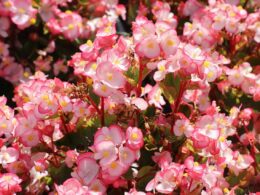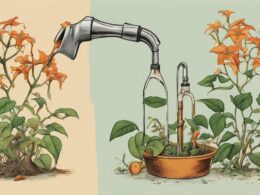Identifying Tuberous Begonias
Distinguishing between tuberous and fibrous begonias is essential for their proper care and growth. In this section, you’ll learn the key characteristics that set tuberous begonias apart, helping you identify them with confidence. Foliage and flowers: Pay close attention to the appearance of your begonia’s leaves and blooms. Tuberous begonias often have large, showy flowers in bright colors like red, orange, pink, or yellow, while fibrous begonias typically have smaller flowers. Additionally, the leaves of tuberous begonias are frequently thick and waxier compared to the thin, serrated foliage of fibrous begonias. Growth habits: Another notable difference exists in the growth habits of these two types. Tuberous begonias are more likely to be grown as annuals or seasonal plants, as they enter dormancy in the winter and require their tubers to be stored in a cool, dry place. On the other hand, fibrous begonias are usually grown as perennials or houseplants, without the need for dormancy. Here’s a brief summary of the differences between tuberous and fibrous begonias:| Feature | Tuberous Begonias | Fibrous Begonias |
|---|---|---|
| Flowers | Large, showy | Smaller |
| Foliage | Thick, waxy | Thin, serrated |
| Growth | Annual, seasonal | Perennial, continuous |
- Tuberous begonias usually prefer indirect sunlight, whereas fibrous begonias can tolerate a range of light conditions.
- Tuberous begonias often have a more upright growth habit, while fibrous begonias may sprawl or cascade.
Recognizing Fibrous Begonias
Distinguishing between tuberous and fibrous begonias can be a bit tricky if you’re not familiar with their subtle differences. In this section, we’ll focus on how to recognize fibrous begonias. Being able to spot these differences will help you give your begonias the proper care they need. First, observe the roots. Fibrous begonias have, as their name suggests, a dense collection of fibrous roots. These roots spread out beneath the soil surface, forming a compact network. In contrast, tuberous begonias have swollen underground storage organs known as tubers which store energy and nutrients during the dormant period. Next, take a look at the leaves. Generally speaking, fibrous begonias have smaller leaves than tuberous begonias, which often sport larger and more dramatic foliage. Additionally, fibrous begonias tend to have thinner, less textured leaves, while tuberous begonias have thicker, more textured leaves. To further differentiate between the two, consider the following characteristics unique to fibrous begonias:- Flowers: Fibrous begonias often produce multiple smaller flowers, while tuberous begonias boast larger, more vibrant blossoms.
- Growing Season: Fibrous begonias typically grow and bloom throughout the year, as opposed to tuberous begonias, which have a more pronounced dormant period during winter months.
| Characteristic | Fibrous Begonias | Tuberous Begonias |
|---|---|---|
| Roots | Dense network of fibers | Swollen tubers |
| Leaves | Smaller, thinner | Larger, more textured |
| Flowers | Multiple, smaller flowers | Larger, vibrant blooms |
| Growing Season | Year-round growth and bloom | Dormant in winter |
Understanding Begonia Growth Habits
Distinguishing between tuberous and fibrous begonias is crucial for providing the proper care for your plant. To determine which type of begonia you have, it’s essential to examine their growth habits and physical characteristics. Tuberous begonias are characterized by their enlarged underground structures called tubers. These tubers store nutrients and water for the plant’s survival and growth, similar to how bulbs function. You’ll find that tuberous begonias have:- More delicate flowers, often appearing in clusters
- A dormant period during colder months, with leaves dying back
- Rounded leaves with a slightly fuzzy texture
- An affinity for thriving in shady areas with indirect sunlight
- Smaller, waxy flowers that are usually unremarkable compared to their foliage
- No dormancy period, allowing year-round growth
- Leaves that are more elongated, sometimes with a wing-shaped appearance
- A preference for partial sun, adaptable to various lighting conditions
| Trait | Tuberous Begonia | Fibrous Begonia |
|---|---|---|
| Flowers | Delicate and clustered | Smaller and waxy |
| Dormancy | Yes, in colder months | No, year-round growth |
| Leaves | Rounded and slightly fuzzy | Elongated and wing-shaped |
| Light Requirements | Shady with indirect sunlight | Partial sun, adaptable |
Examining Root Structures
To determine whether your begonia is tuberous or fibrous, a closer look at its root structure is essential. In this section, we’ll walk you through the examination process and provide some helpful tips to distinguish between the two types of begonias based on their roots. Before beginning, gently remove your begonia from its pot to carefully examine the roots. Be cautious not to damage the roots during this process. Tuberous and fibrous begonias can be easily distinguished by observing these key features:- Tuberous Roots: These roots are thick and fleshy structures that store nutrients and water. They have a more compact, round formation at the base of the plant. Tuberous begonias often go dormant during colder months, leaving the tuber behind. If you find a round, fleshy mass at the base, it’s likely that your begonia is tuberous.
- Fibrous Roots: Unlike tuberous roots, fibrous roots are slender and thread-like. They form a dense, hair-like network that covers a larger soil surface area. If the roots of your begonia don’t display a fleshy, rounded structure and instead appear thin and sprawling, your plant is probably a fibrous begonia.
- Leaf shape and color: Tuberous begonias often have larger, more asymmetrical leaves, while fibrous begonias tend to have smaller, symmetrical leaves. Moreover, tuberous begonias may exhibit foliage with an array of colors, whereas fibrous begonias typically have green or bronze leaves.
- Blooms: Tuberous begonias are known for their showy, large flowers that come in a wide variety of colors. Fibrous begonias, on the other hand, have smaller blooms, which are usually white, pink, or red.
Observing Flower and Leaf Traits
To determine if your begonia is tuberous or fibrous, it’s essential to observe the flower and leaf traits of your plant closely. By doing this, you can easily identify the type of begonia you have and provide proper care. We’ll dive into specific characteristics to look for that will help you differentiate between these two types of begonias. Flower traits can be a useful indicator to distinguish between tuberous and fibrous begonias. Some differences include:- Tuberous begonias:
- Generally have larger, more vibrant flowers
- Flowers can be single or double petaled
- Often display showy blooms in shades of red, pink, orange, yellow, and white
- Fibrous begonias:
- Tend to exhibit smaller, less showy flowers
- Often bloom in lighter shades of red, pink, and white
- Primarily have green foliage, but some varieties contain bronze or red-tinted leaves
| Tuberous Begonias | Fibrous Begonias |
|---|---|
| Generally round or heart-shaped leaves | Usually elongated, oval-shaped leaves |
| Leaves have a velvety or fuzzy texture | Smooth-leaved varieties prevail |
| Edged with tiny hairs and sometimes serrated | Sometimes serrated margin, but often smooth |
- Tuberous begonias:
- Grow from an enlarged underground storage organ (tuber)
- Typically have a more pronounced dormant period in colder months
- Can be grown as perennials or annuals, depending on the climate
- Fibrous begonias:
- Grow from a mass of fibrous roots
- Typically evergreen, with no definite dormancy period
- Often treated as annuals, although some varieties can be grown as perennials in warmer climates
Assessing Winter Dormancy Patterns
When you’re trying to figure out if your begonia is tuberous or fibrous, you’ll want to pay close attention to its winter dormancy patterns. This is a key difference between the two types of begonias, and understanding it can help you easily identify which type you have. Tuberous begonias usually undergo a period of winter dormancy, during which they lose their leaves and stop growing. It’s during this time that their tubers store energy for the next growing season. To determine if your begonia is tuberous, look for these signs of winter dormancy:- Leaves turning yellow and falling off
- Slowing down or cessation of growth
- Flower buds not forming or developing
- Continuous growth and development of new leaves
- Flower production throughout the year
- No significant leaf drop or yellowing during winter months
- Temperature: Tuberous begonias have a higher likelihood of entering dormancy when exposed to cooler temperatures over an extended period. If your begonia is in a cold room or near a drafty window, it might enter dormancy even if it’s not a tuberous variety.
- Light: Both types of begonias need good light to thrive; however, fibrous begonias can tolerate lower light levels than tuberous begonias. If your begonia is in a spot with limited light during the winter months and still continues to grow and flower, it’s more likely to be a fibrous variety.
- Watering: Overwatering or underwatering your begonia might cause it to go dormant or experience stress, potentially leading to similar symptoms as winter dormancy. Make sure you’re providing the proper water and care to ensure you’re making an accurate assessment.
Caring for Tuberous and Fibrous Begonias
Knowing the difference between tuberous and fibrous begonias is essential for providing them with the appropriate care. Both types have their own unique set of requirements, and understanding these will help you maintain healthy, happy begonias. Tuberous begonias grow from tubers, which are underground storage organs. These plants have a dormancy period that typically occurs during the winter months. To care for tuberous begonias, follow these guidelines:- Give them indirect sunlight or partial shade, as they don’t handle direct sunlight well.
- Keep the soil slightly moist, never letting it dry completely.
- Fertilize with a balanced, slow-release fertilizer every six to eight weeks during the growing season.
- In late fall, cut back on watering to encourage dormancy.
- Store the tubers indoors during winter in a cool, dark, and dry place.
- Provide bright indirect sunlight or partial shade, similar to their tuberous counterparts.
- Keep the soil evenly moist but not soggy, as they’re sensitive to both under- and over-watering.
- Fertilize with a balanced, water-soluble fertilizer every four weeks during the growing season.
| Feature | Tuberous Begonias | Fibrous Begonias |
|---|---|---|
| Sunlight | Indirect sunlight or partial shade | Bright indirect sunlight or partial shade |
| Soil Moisture | Slightly moist | Evenly moist |
| Fertilizer | Balanced, slow-release (every 6-8 weeks) | Balanced, water-soluble (every 4 weeks) |
| Dormancy | Required (winter months) | Not required (year-round growth) |
- Monitor for pests and diseases such as aphids, mealybugs, or mildew, and treat promptly if detected.
- Prune your begonias regularly to remove dead or damaged foliage, which will encourage bushier growth and overall health.
- Keep in mind that container-grown begonias may require more frequent watering than garden-grown plants.
Should I Deadhead Tuberous Begonias?
Deadheading begonias is a crucial practice to maintain the blooming beauty of tuberous Begonias. By removing faded flowers promptly, you encourage new growth and prolong the flowering season. Deadheading redirects the plant’s energy towards producing new blooms instead of seed production, ultimately enhancing the overall appearance of your begonias.
Tips for Propagating Your Begonias
Knowing how to propagate your begonias can help you grow a robust and healthy collection. Here are some tips to get you started: 1. Choose the right method: Depending on whether you have a tuberous or fibrous begonia, you’ll want to pick the appropriate propagation technique. Tuberous begonias can be propagated through tuber division or leaf cuttings, while fibrous begonias are better suited for stem or leaf cuttings. 2. Timing is crucial: The best time to propagate begonias is during their active growth phase, which typically occurs in spring or early summer. You’ll have a higher success rate if you time your propagation efforts right.- Prepare your tools: Make sure you’ve got the following items on hand before you start propagating:
- A sharp, clean knife or garden shears
- Well-draining potting mix
- Rooting hormone (optional but helpful)
- Small pots or seedling trays
- Plastic bags or clear containers to create a humidity chamber
- Propagating begonias is a rewarding endeavor, and with the right care and attention, you’ll have a thriving collection in no time. Follow these tips, and your begonia propagation journey will be off to a great start!
Key Differences and Similarities
Figuring out whether your begonia is tuberous or fibrous can be confusing, but understanding the key differences and similarities will make it easier for you to identify your plant’s classification. Let’s explore the main factors that set these two begonia types apart:Growth Patterns
Tuberous begonias grow from tubers, which are swollen underground structures capable of storing nutrients. They thrive in well-drained soil and produce an extensive root system. Their vibrant blooms appear during the summer months and go dormant in winter. On the other hand, fibrous begonias grow from a fibrous root system, originating directly from the stem. These begonias, unlike tuberous ones, can bloom all year round in the right conditions, making them popular as perennial indoor or outdoor plants.Foliage and Flowering
Tuberous begonias are known for their large, showy flowers that come in various colors such as red, pink, orange, and yellow. The leaves of tuberous begonias tend to be heart-shaped and slightly fleshy. Fibrous begonias, in contrast, produce smaller flowers that are typically pink, red, or white. Their foliage is more diverse, with some varieties featuring variegated, serrated, or angel wing-shaped leaves.Cultivation Requirements
Tuberous and fibrous begonias have similar cultivation requirements in terms of light, soil, and water. Both types need:- Bright, indirect light
- Well-draining soil with a slightly acidic pH
- Even moisture levels without being overly wet
- Observe your begonia’s flowering and foliage characteristics
- Consider the timing and duration of the blooming period
- Reflect on any dormant periods the plant may experience
- Examine the root structure, if possible (tuberous vs. fibrous)
In Conclusion
Identifying whether your begonia is tuberous or fibrous may not initially appear straightforward. Nonetheless, by closely observing your plant’s characteristics, the process can become a more manageable task. Let’s recap the key points to consider:- Root System: Tuberous begonias have swollen, thickened root structures called tubers. Fibrous begonias, on the other hand, possess a more standard root system with thin, thread-like roots.
- Growing Season: Tuberous begonias flourish during the warmer months, typically becoming dormant during winter. Fibrous begonias grow and bloom year-round under the right conditions, with continuous growth instead of dormancy.
- Bloom Type: Tuberous begonias are known for their large, showy flowers, while fibrous begonias generally have smaller blooms and often more vibrant foliage.
| Characteristic | Tuberous Begonia | Fibrous Begonia |
|---|---|---|
| Root System | Swollen, thickened tuber | Thin, thread-like roots |
| Growing Season | Warm months, dormancy in winter | Year-round, continuous growth |
| Bloom Type | Large, showy flowers | Smaller blooms, vibrant foliage |









